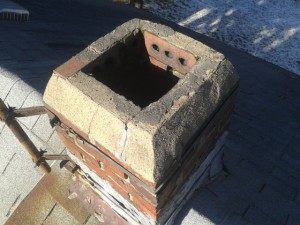Chimney Caps and Raccoons in the Attic
 You see this picture and you see an uncapped chimney. Ho hum.
You see this picture and you see an uncapped chimney. Ho hum.
A raccoon, on the other hand, sees it as a great curiosity- something to be checked out and explored. Is it a great place to live? Is it safe? Is it warm? Would this be a great place to have a litter of raccoons? Is the smell of female raccoons present?
There are multiple reasons to have properly designed and fitting chimney caps in place.
From our perspective as nuisance animal removers, one of the best reasons for chimney caps is that they tell nuisance raccons to: “Move along. There’s nothing to see here.”
The danger in not having a capped chimney when it comes to raccoons is:
- They can obviously go in chimneys and take up residence
- Or, it encourages them to stay around and explore which could lead to even bigger problems–like a raccoon in the attic.
And that is the story of our blog today:
A raccoon that eventually found its way into an attic because they were attracted to the area by an uncapped chimney.
Raccoons Explore Roofs
Raccoons love to explore roofs. Why? Because their natural denning areas are in hollows of trees high above the ground where predators lurk. For this reason, places they have to climb to get to are associated with safety. It makes sense: no coyote (or dog) is going to be able to follow them up into a beech tree (or onto your roof ) to get them or their young.
So when they’ve had enough to eat, raccoons are sure to be found exploring; looking for new food sources and safe places to den.
Which brings them to your roof. Looking. Exploring. Seeing if there is any survival advantage to be gained by being on your roof.
And when they find something as interesting as an uncapped chimney, they’re sure to explore it thoroughly.
Beyond Raccoons in the Chimney
Raccoons are great climbers and will live in chimneys. Without a chimney cap, raccoons are invited to climb down and see if it would be a good place to live.
We’ve covered raccoons living in chimneys before and we’re sure to do it again in the future.
Instead, today we’re going to look at the less obvious result of not having a chimney cap–encouraging raccoons on the roof to explore and, eventully, find their way into the attic.
In the video below, Ryan shows us a job last week where this was the case. A raccoon was in the attic because, with enough exploration in the vicinity of the uncapped chimney, it was able to find a weak spot.
After finding the weakness next to the chimney, the raccoon then had it’s choice between the masonry chimney or the cozy, insulated attic. Not a hard choice.

The bent flashing is the current problem leading to raccoon (and water!) entry into this attic, but it is a great example of a case where an uncapped chimney got the attention of a raccoon and is at the root of this problem.
Raccoon Removal | Chimney Caps | Repairs
So here it is, our tip for the day:
Cap that chimney! The more time a raccoon spends on your roof, the more likely they will find a way into your attic. You don’t want animals in your chimney…and, more importantly, you surely don’t want them in your attic.
For help with raccoons in the chimney, raccoons in the attic, or raccoon removal in general:
We have professional solutions for all of your raccoon problems around the Akron, Canton, Kent, Ohio area.
Please call us and check out the rest of our web page:

